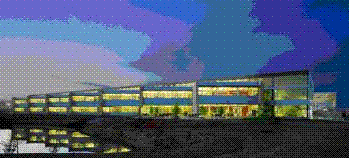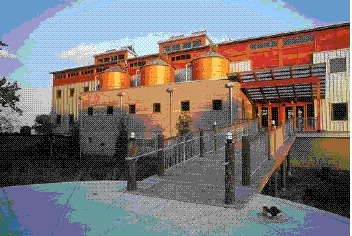Platinum graded buildings

Alberici Corporate Headquarters
Overview
- Location: Overland, MO
- Building type(s): Commercial office
- 73% new construction, 27% renovation
- 109,000 sq. feet (10,100 sq. meters)
- Suburban setting
- Completed December 2004
- Rating: U.S. Green Building Council LEED-NC, v.2/v.2.1–Level: Platinum (60 points)
Rating: Green Globes –Level: Four Green Globes
This project entails the adaptive reuse of an existing manufacturing plant into a corporate headquarters for one of St. Louis’ oldest and largest construction companies. Requirements included an open office environment, structured parking, training rooms, exercise facilities, and dining facilities.
When company growth led to the decision to move, the company CEO “wanted to be in a place that fosters teamwork and creativity.” After investigating 45 different sites, a brownfield site became available with a 1950s office building and a 155,633 ft2 former metal manufacturing facility. With 70′ and 90′ clear-span bays 505′ long, it was a “cathedral of steel.”
Environmental Aspects
The client wanted to lead by example and transform the design and construction marketplace. The team and client achieved their goal of Platinum LEED(r) certification; the project earned 60 points, the highest total ever. The company now enjoys a healthy, comfortable, beautiful environment that fosters teamwork, creativity, and collaboration, and a 50-year-old structure has new life.
The original manufacturing plant faced southwest—a difficult solar orientation. The addition of a “saw-tooth” patterned wall of offices in effect reoriented the building due south and provided ample glazing while blocking western sunlight with masonry walls. External sunscreens effectively block unwanted solar gain.
By selectively removing the roof deck in the second bay of the industrial building, a courtyard was formed between the garage and office building. Two bays were adaptively reused as structured parking, and all surface parking was eliminated.
The interiors are organized around three large atria and receive abundant light, fresh air, and views to the outdoors. In addition to visually uniting the two floors, the atria act as thermal flues to induce ventilation. The open-plan environment fosters teamwork and collaboration while affording 90% of building occupants direct views to the outdoors.
Sustainable design led to doing more with less and solving multiple issues with each response.
Owner & Occupancy
Owned and occupied by Alberici Corporation, Corporation, for-profit Typically occupied by 200 people, 40 hours per person per week; and 150 visitors per week, 2 hours per visitor per week
Audubon Center at Debs Park
Overview
· Location: Los Angeles, CA · Building type(s): Interpretive Center, Recreation, Park · New construction · 5,020 sq. feet (467 sq. meters) · Project scope: a single building · Urban setting · Completed November 2003 · Rating: U.S. Green Building Council LEED-NC, v.2/v.2.1–Level: Platinum (53 points)
Rating: Zero Energy Building –Level: Near Zero
Located just ten minutes northeast of downtown Los Angeles, Ernest E. Debs Regional Park is a 282-acre urban wilderness owned by the Los Angeles Department of Recreation and Parks. The Audubon Center at Debs Park occupies 17 acres of the park, leased from the City.
The focus of the project is environmental education. The Center provides educational programs for the 50,000 schoolchildren who live within two miles of the park. It includes a multipurpose “Discovery Room,” for teaching and displays, a library and meeting room, a reception area, a gift shop, and a catering kitchen. The Debs Park facility is part of the Audubon Society’s focus on establishing Centers in urban and underserved communities.
Environmental Aspects
The Audubon Center at Debs Park is the National Audubon Society’s first nature center in California to be constructed from the ground up using environmentally sensitive design techniques. It is also the first building in the U.S. to achieve a Platinum rating under version 2 of the U.S. Green Building Council’s Leadership in Energy and Environmental Design (LEED(R)) Rating System.
The Center is operated entirely off-grid, using only power generated on site. It is expected to use only 25,000 kWh of energy each year (around five kWh per square foot). The Center is designed to use 70% less water than a comparable conventional building, and to treat all wastewater on site. More than 50% of the building materials were manufactured locally, and more than 97% of construction debris was recycled.
The National Audubon Society plans to build a thousand urban facilities around the country by 2020.
Owner & Occupancy
· Owned and occupied by The National Audubon Society, Corporation, nonprofit · Typically occupied by 8 people, 40 hours per person per week
Building Programs
| Indoor Spaces: | Retail general, Lobby/reception, Other, Classroom, Restrooms, Circulation, Office |
| Outdoor Spaces: | Wildlife habitat, Parking, Drives/roadway, Pedestrian/non-motorized vehicle path, Interpretive landscape, Restored landscape |

Overview
· Location: Annapolis, MD · Building type(s): Interpretive Center, Commercial office · New construction · 32,000 sq. feet (2,970 sq. meters) · Project scope: 2-story building · Suburban setting · Completed December 2000 · Rating: U.S. Green Building Council LEED-NC, v.1.0–Level: Platinum
Rating: Green Building Challenge –Level: 2.7 in GB Tool 1.76
The Chesapeake Bay Foundation, an environmental advocacy, restoration, and education organization, is headquartered in Annapolis, Maryland.
Environmental Aspects
The Chesapeake Bay Foundation Headquarters building is recognized as one of the “greenest” buildings ever constructed. Sustainability issues ranging from energy use to material selection were given serious consideration throughout design and construction of this facility. It was the first building to receive a Platinum rating through the U.S. Green Building Council’s LEED (Leadership in Energy and Environmental Design) Rating System, version 1.0.
Owner & Occupancy
· Owned and occupied by The Chesapeake Bay Foundation Inc., Corporation, nonprofit · Typically occupied by 80 people, 40 hours per person per week
This conventional office environment is open 8:30 AM to 5:30 PM. Weekend and evening functions are occasionally held at the Center.
Building Programs
| Indoor Spaces: | Office (65%), Conference (10%), Mechanical systems (9%), Lobby/reception (4%), Circulation (4%), Restrooms (3%), Electrical systems (3%), Dining (2%) |
| Outdoor Spaces: | Restored landscape (48%), Wildlife habitat (40%), Parking (5%), Interpretive landscape (2%), Drives/roadway (2%), Pedestrian/non-motorized vehicle path (2%), Patio/hardscape (1%) |
